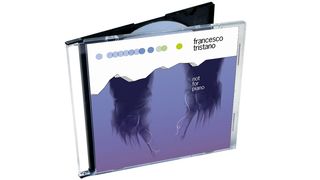Although he was studying classical music at the Juilliard School in New York, Francesco Tristano was receiving his real education from the city’s thriving club scene. By day he was soaking up dusty grand masters like Bach, but by night he was throwing shapes to the pulsing music of Jeff Mills and Autechre.
“I thought it was fascinating,” admits Francesco. “I just had to learn to integrate this language into my own music.”
The piano prodigy began to experiment, playing classic techno music in a classical way, leading to his own piano-led breakthrough version of Derrick May’s seminal Strings of Life, which he performed live at a Paris show in early 2005.
His grandiose interpretation caught the ear of the men behind the InFiné Music label, who signed Tristano as its first star, and work set about on the album, Not For Piano. A first of its kind - he would take vintage techno and reimagine it through classical piano.
Besides Strings of Life, he added covers of Jeff Mills’ The Bells, and reevaluated Autechre’s blissful Overand, renaming it Andover. As well as contributing solo piano originals and duets across its length.
Don’t get it twisted - the results are far from pounding or bleepy 4/4 treatments. Tristano leads the way with trad piano playing. Yet there are subtle digital elements woven in by the deft touches of producer, Murcof.
“He took the edits of my live playing and added the right intrigue with soft synths and vocoders”, says Tristano. “It meant an electronic music fan would go, ‘Oh, there’s a piano playing, but I hear little digital jitters that catch my attention’. It really gave the tracks another level.”
The resulting album would go on to receive high praise from both dance and classical fans alike. As well as setting Tristano onto a path of straight-up electronic music, later releasing bangers on M.A.N.D.Y’s Get Physical Music label.
“This album opened so many doors for me,” says Tristano. “It made everyone aware of this little asshole playing the piano but kind of wanting to be in the techno realm, in a way.”
Here, Francesco takes us through Not For Piano, track by track.

Hello
“The title itself is an homage to Kenny Larkin, who years previously had also released an album [1994’s Azimuth] that had started with a track called Hello.
“This track is my work in progress. I still perform this piece now. It has grown a lot; it encapsulates who I am most. That’s why I keep rewriting and developing it. It started as a pianistic loop. Then, when I was later in the studio with Carl Craig, remixing it, it became Hello (Inner Space Dub) and we put it on my Idiosynkrasia album.
“When I have a piano show, I like to start with Hello. It gives me a chance to feel out the audience and groove for a little while. I think it’s the most important piece on the album because it’s me. And it’s still me ten years later.”
Barceloneta Trist
“Barceloneta is the beach front of Barcelona. The melody just occurred to me walking down the path there by the sea. Trist also means sad, as well as being part of my name.
“It’s quite an unusual track for me as it was quite written out and quite jazzy in its harmonies.
“We’ve just actually done a new version with Carl Craig called Barceloneta Trist vs. Version, with a full orchestra.
“Occasionally, I do play this in my shows. I have a version I do with Pascal Schumacher, who is a vibraphone player, and Bachar Khalifé. We rerecorded this piece as a trio about three or four years ago.
“[Mexican electronica artist Fernando Corona] Murcof adds some magic with little delays and some post-production on the chords looping in the background. His work was really important on this track.”
Strings Of Life
“I’d recorded this a couple of times before we hit on this version. The cool thing was that it wasn’t recorded to a click track. So you have quite a large dynamic range in terms of tempo. You can stride forward. I’m so happy I didn’t use a click track. If you’re using one, as 98% of people today do, you get the precision and steadiness of the beat, but you lose the intention of the music.
“If you’re going to play to a click track, you’re going to have a set limit. If you lose it, there can be no limit to your expression. If the music takes you a notch faster or slower, it’s because the music wanted it like this.
“I did a few takes and tried to do an edit for the album version, but in the end we just took pretty much one full take, with one minor edit to correct some unclarities in the take.
“There is a more steady version of this out there that I used for the remix album. You couldn’t beat-match the album version [laughs].”
Andover
“This is a piece by Autechre that was originally called Overand. For me, Autechre make the greatest electronic music ever made. Their Tri Repetae album was one of the big features in my life when I started to listen to electronic music. Their first five albums were very important to me.
“I just started to play the melody on piano and thought I could bring something out of it. Here Fernando Corona [aka Murcof] really took the piece to another level, adding this vocoder synth to the music.
“When I moved to New York, there was many an evening when we would listen to this track over and over with my friends. It just settled into my body and system until I made my own version of it.”
AP*
“This my tribute to Pascal Dusapin, the French composer. He has a few operas. He makes very intense contemporary music.
“There’s some improvisation, but there are some themes in terms of harmony and melody. It’s like a gesture, which is why it has that asterisk. It’s two minutes and 40 seconds of some wild piano language which doesn’t quite fit in. It’s a break from whatever came before; it’s like a palette cleanser, or a slap in the face.
“It’s unsettling and weird in terms of harmonic language. All the stuff before was pretty melodic, but this track is an exception.”
“It’s unsettling and weird in terms of harmonic language. All the stuff before was pretty melodic, but this track is an exception.”
The Melody
“This turned out to be the big track. It started out as a version by me and my mate Rami Khalife. Then I went in the studio alone and made something, but I wasn’t sure if it was too commercial. I played my label boss a few bars and he said, ‘Are you crazy? We need this. You have to record it!’
“It’s funny, a month ago I was talking to Luciano on the phone, and he was congratulating me for this piece. I had to tell him it wasn’t new, it was ten years old [laughs].
“I don’t know. It’s clearly a crowdpleaser. Especially with the Balil [aka Ed Handley of Plaid] remix. I think that’s the best remix that has ever been made of my music. I loved the way Ed turned ‘the melody’ upside down and changed the harmonies. It was quite brilliant.”
Jeita
“Jeita is actually a grotto [underground cave system] in Lebanon, which me and my ex-brother from another mother, Rami Khalife, played in a few years earlier. It was an amazing place because it’s quite far in. You have to walk about a kilometre to get there, but on the way there are all these stalactites and stalagmites.
“The reverb in there was about seven seconds and made for the craziest acoustics I’ve ever played in. Like I say, it was remote. It took about six hours just to get my piano down there. So this piece is reminiscent of my time in there.
“There is another, more epic, version of this track that I did with Rami on my album, Pop Art.”
The Bells
“This, of course, is a version of the very recognisable Jeff Mills track, The Bells. We got a chance to play this version for Jeff Mills in Barcelona one year previous to the recording. He came up to us and said, ‘Guys, this is amazing. What you are doing with this? The drama is unbelievable!’. I remember he kept talking about ‘the drama’. He said, ‘This is exactly what we’re trying to do with the machines. Except machines are rigid and kind of stupid. To make them act dramatic you have to go beyond the machines’ limits. The way you use the piano to play techno is how we’ve always envisaged it.’ And this was before his Blue Potential recording with the Montpellier Philharmonic Orchestra.
“His support was very important to us when we were 20 years old. To get the support of a titan like Jeff Mills really encouraged me to get into more electronic music through the piano.”

Hymn
“This is really a continuation of The Bells. It has a jump cut. We had three hours of takes, with just me and Rami jamming on the piano. Then we found one passage that we liked, but we had to make it fit. So we just considered it like a DJ set, with one track finishing up, and then the next one coming in. We just spliced it diagonally.
“It’s quite crass, but I kind of like it. It comes out of nowhere and there it is. It’s quite housey.
“Me and Rami studied together at Juilliard. We basically listened to a lot of electronic music together in the evenings and just locked ourselves in and played techno-oriented stuff on piano for hours and hours. Hymn was one of those moments where we could just get into one of those harmonic loops and just play over and over.”
Two Minds One Sound
“This title is the name of the project I have with Raimundo Penaforte. We’ve been playing for a long time. Our last show was about a year ago. Raimundo is a crazy motherfucker. He’s one of the wildest musicians I know, because he doesn’t even need an instrument. If you just give him a pen or a cup of coffee he could play a whole show.
“I actually recorded this one to a click track, because I knew I needed some percussion on it. I needed some Brazilian craziness, so I got Raimundo Penaforte in. We recorded him in New York with my friend Kyle for one afternoon. He just used whatever was lying around.
“There were some percussion things, but also a lot of non-instruments. Just taking random stuff in the room and holding it near the mic and grooving.
“For me it was clear it was going to be the last track. It’s just such a celebration of life.”
For all the latest news on Francesco Tristano, including new Derrick May collabs, visit his official website.




